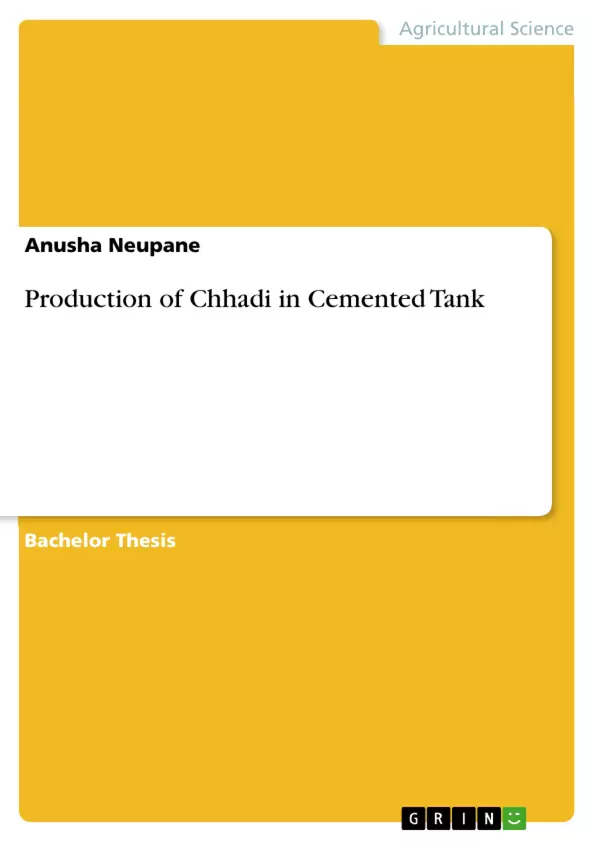Farming of Mrigal (Cirrhinus mrigala) and Rohu (Labeo rohita) under single stocking and multiple harvesting to produce finger size fish, called Chhadi, is emerging rapidly in Nepal. The culture of Chhadi fish was conducted for the period of 90 days from 15th Sept to 15th Dec, 2023 to investigate its production and gross margin. A cemented tank of 25 m² in size was used to calculate its growth, yield and survival. Fry of Mrigal and Rohu with an average size of 1.37±1.14 g and 2.92±1.02 g respectively were stocked at the stocking density of 15 fry/m². The ratio of Mrigal and Rohu was 9:1. Pond preparation was done to create suitable conditions for Chhadi production, Urea and DAP were used at doses of 4.7 g/m²/week and 3.5 g/m²/week respectively. The feeding was done at 5% body weight at initial 2 months twice a day and at last 1 month used 3% of body weight using pelleted feed which was prepared using mustard oil cake, rice bran and soyabean meal in 2:2:1 ratio. Water quality parameters DO, temperature, pH and Secchi disc visibility were recorded daily. The average temperature at morning (7 AM) and afternoon (3 PM) were 25.2±4.5 °C and 28.6±4.2 °C respectively, average DO at morning and afternoon; 4.3±1.4 mg/L and 7.3±1.2 mg/L respectively, average pH at morning and afternoon 8.1±0.3 and 8.3±0.2 and Secchi disc visibility at 11 AM was 39.2±14.8. During the culture period, sampling was conducted at a fifteen days interval to ensure the growth rate and for feed adjustment. From the study, the average harvested weight of Rohu and Mrigal was 33.21±8.6 and 26.25±5.70 g/fish respectively. Similarly, the total weight gain of Rohu was 853 g/tank and that of Mrigal was 6770 g/tank. The overall survival rate of Chhadi was 87.93%. The overall extrapolated GFY and NFY were 12.99 t/ha/yr and 12.36 t/ha/yr respectively while the AFCR was 1.28. The B/C ratio of Chhadi production during the culture period was 1.73.
Inhaltsverzeichnis (Table of Contents)
- Introduction
- Background
- Objectives
- General objective
- Specific objectives
- Rationale of the study
- Limitation of the study
- Literature Review
- Status of Chhadi in Nepal
- General description of species
- Cirrhinus mrigala (Hamilton, 1822)
- Labeo rohita (Hamilton, 1822)
- Culture system
- Supplemental feed and feeding
- Materials and Methods
- ELE Site
- Cemented tank preparation
- Drying and cleaning
- Salting
- Water filling
- Pond fertilization
- Procurement and stocking
- Post stocking management
- Feed and feeding
- Water management
- Fish sampling and growth check
- Water quality monitoring
- Fish harvesting and Marketing
- Analytical methods
Zielsetzung und Themenschwerpunkte (Objectives and Key Themes)
This study investigates the production of Chhadi fish in a cemented tank. The main objective is to document and analyze a specific method of Chhadi cultivation. Key themes explored include optimal tank preparation techniques, effective feeding strategies, and water quality management for successful Chhadi farming.- Chhadi fish cultivation techniques in cemented tanks.
- Water quality parameters and their impact on Chhadi growth.
- Effective feeding strategies for optimal Chhadi growth.
- Preparation and maintenance of cemented tanks for aquaculture.
- Analysis of growth and yield of Chhadi in a controlled environment.
Zusammenfassung der Kapitel (Chapter Summaries)
The introduction lays out the background of Chhadi fish in Nepal, outlining the study's objectives and rationale. The literature review section explores the existing knowledge on Chhadi species, their culture systems, and feeding practices. The materials and methods section details the experimental setup, including tank preparation, stocking, feeding, water management, and monitoring procedures. This section covers the practical steps undertaken in the study.Schlüsselwörter (Keywords)
Chhadi, Cirrhinus mrigala, Labeo rohita, aquaculture, cemented tank, fish farming, Nepal, feeding, water quality, growth, yield.- Quote paper
- Anusha Neupane (Author), 2023, Production of Chhadi in Cemented Tank, Munich, GRIN Verlag, https://www.grin.com/document/1505983



